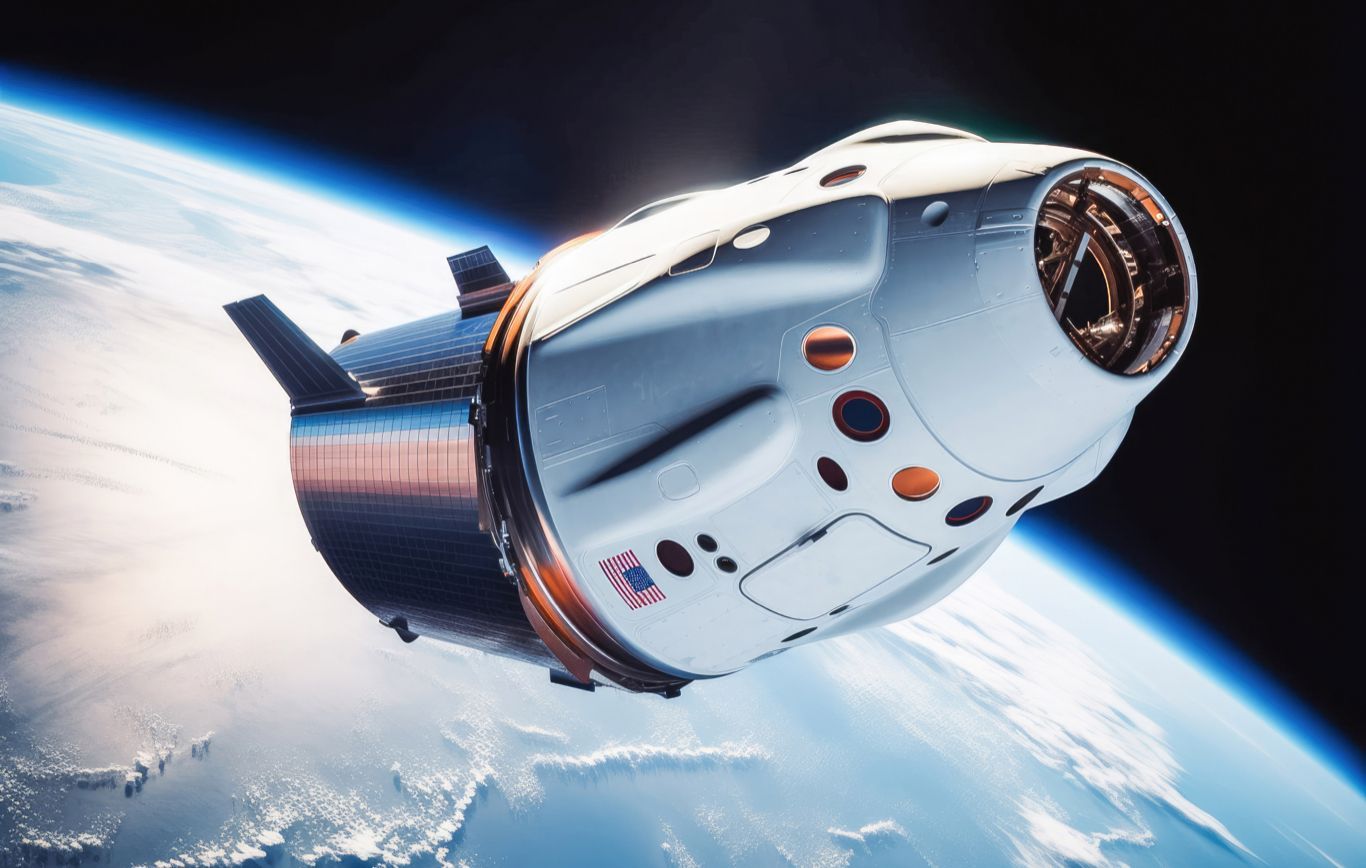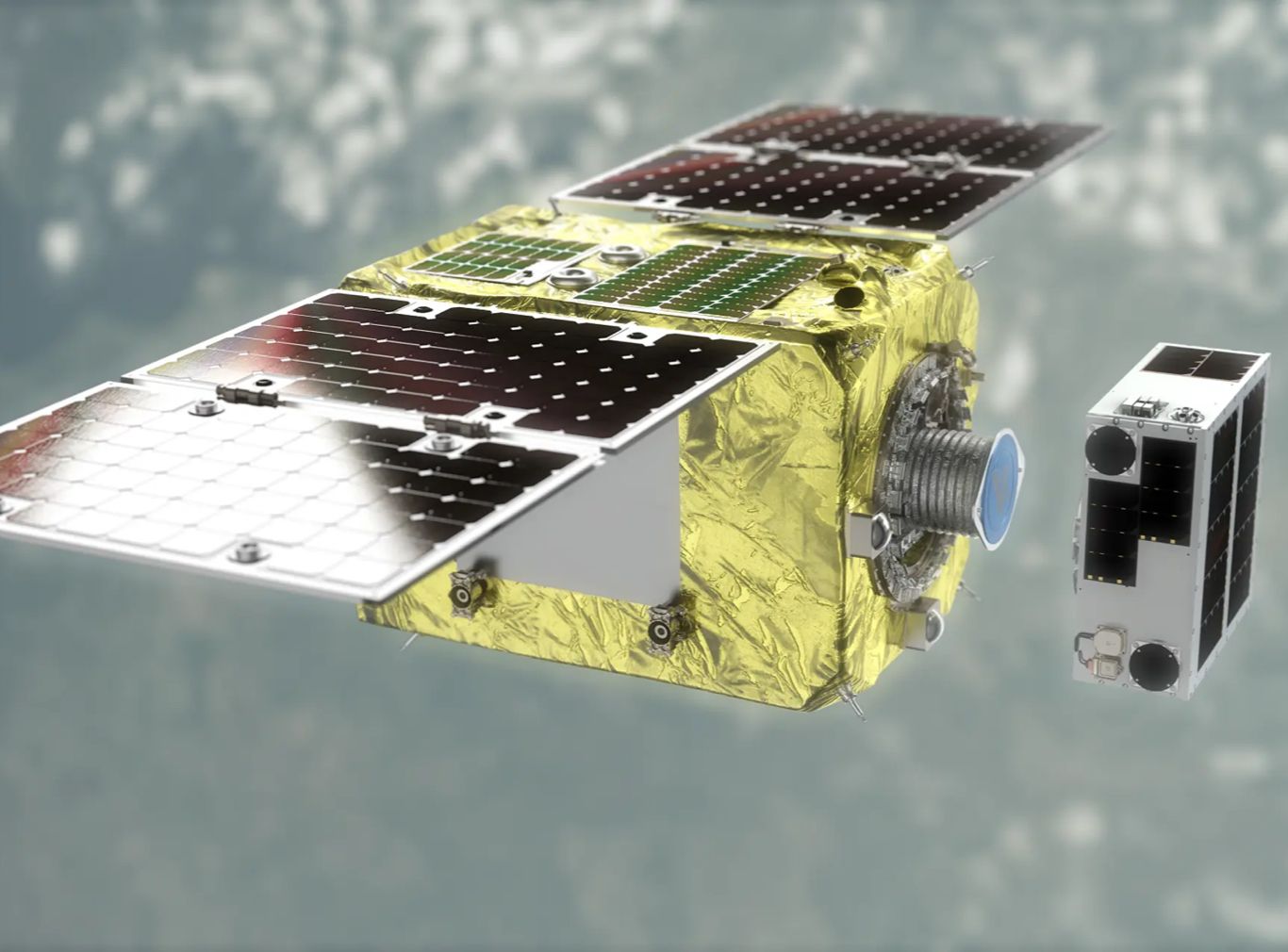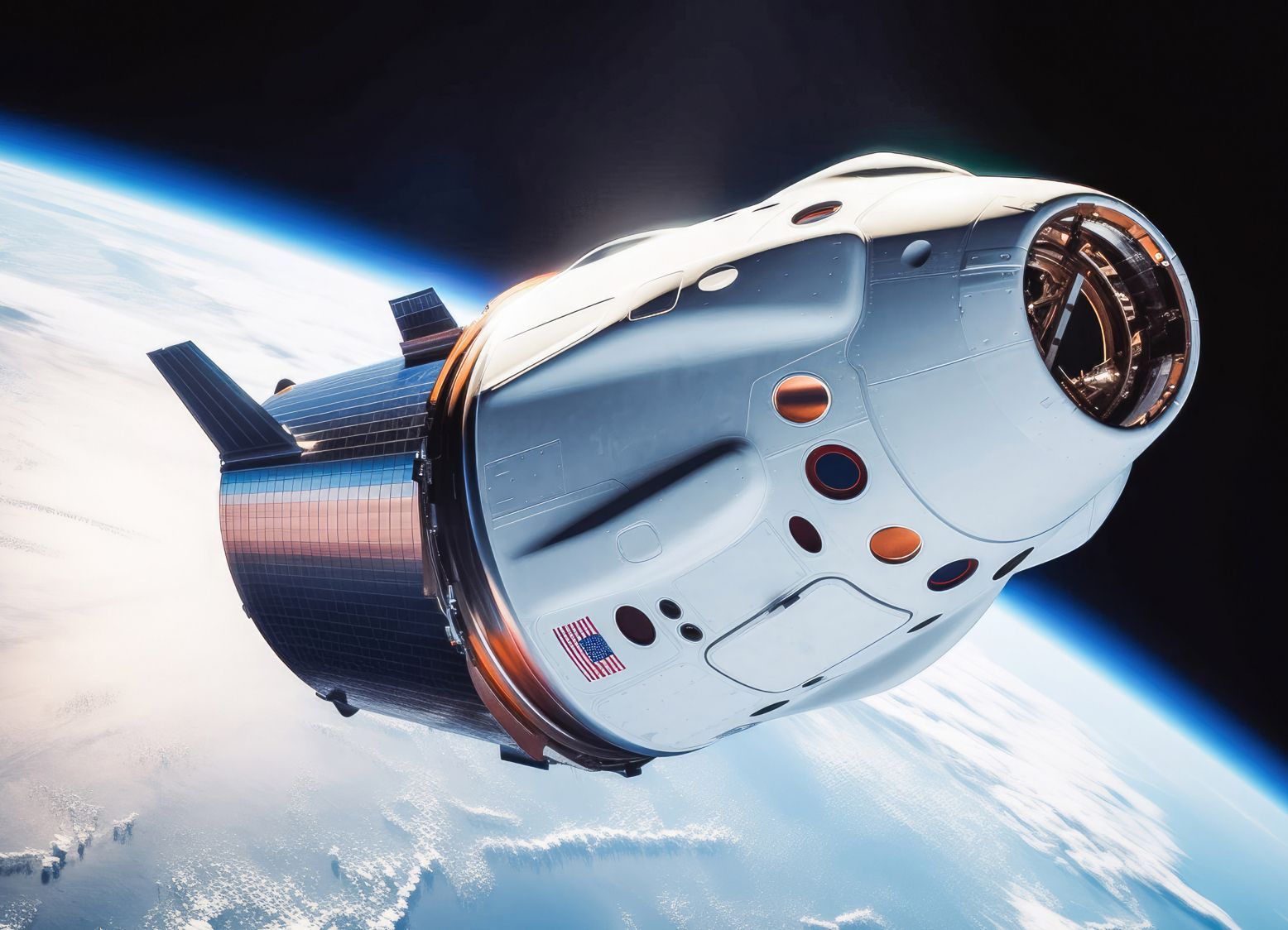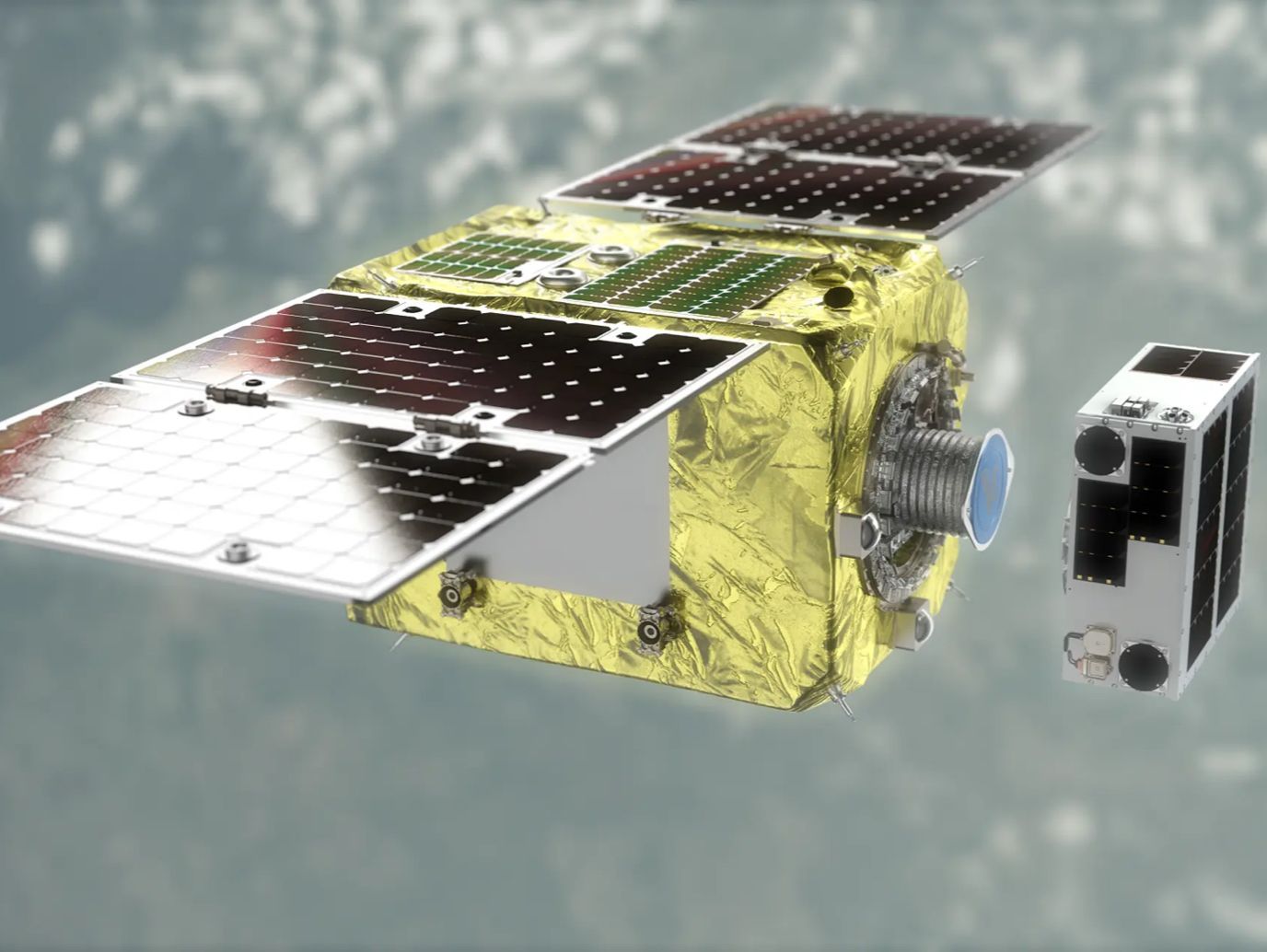04 August 2023
Commercialisation ensuring success in space, focus on debris removal - Space News Roundup

SpaceX Crew Dragon (Image: SpaceX)
There’s no doubt that the success of the growing space industry is the result of commercialisation, through increased efficiency and competition. The days of grand, state-funded space projects are numbered, with NASA’s Artemis programme and the planned launches of their giant SLS rockets perhaps being one of the final such ventures. But that’s not to say that agencies such as NASA no longer play a key role.
In fact, this week NASA provided an update on one of their upcoming, iconic and milestone missions, the Mars Sample Return (MSR) project. NASA’s Perseverance rover is collecting and has cached samples of Martian regolith, ready to be retrieved by a small rocket, supported by two “ingenuity-like” helicopters. Once launched from the Martian surface, another spacecraft would capture it in orbit, and send it back to Earth (NASA).
This week NASA announced that the rocket used to launch the samples, the Mars Ascent Vehicle (MAV), reached some major milestones after conducting successful tests of the the first and second stages. The MAV would be the first rocket to launch from the surface of another planet.
Antares and Starliner face setbacks
While MSR reflects the achievements of grand, state-funded projects, we are increasingly noting the transfer of responsibility and influence to the private sector. Perhaps symbolic of this, Being have reported further losses of $257 million (Q2) on their Starliner spacecraft development. This brings losses up to $1.47 billion since 2016. Starliner is being developed in order to carry crew to and from the ISS, but so far it has been up to SpaceX to carry the load using their far more successful Crew Dragon capsule, demonstrating the rallying success of commercialisation.
Furthermore, this week also saw the launch of the last US Antares rocket, using Russian and Ukrainian parts. US companies Northrop Grumman and Firefly Aerospace are now looking to develop a purely US-made replacement, but are also facing delays, now stating it will fly nor sooner than 2025.
Meanwhile, the private launch market continues to thrive. SpaceX continue breaking launch and reusability records, and while the new Antares might be delayed, it must also be noted that Northrop have called-up Firefly, a New Space startup, to help them develop the new rocket.
An ongoing shift towards commercial space
Interestingly, despite the critical support from the commercial sector, according to a recent Pew Research Center survey of 10,000 US citizens, just 32% of those asked believe that private companies will ensure enough progress is made in space exploration.
This comes at a time when we are seeing milestones being achieved each week by private companies and the commercial sector. One such achievement came this week from SpaceX, launching the world’s heaviest commercial satellite atop a Falcon Heavy rocket. The Jupiter-3 satellite was sent into geosynchronous orbit on behalf of Hughes Network Systems and will double the capacity of their Jupiter broadband fleet.
Also looking towards the commercialisation of Earth-orbit, Airbus have announced that they will collaborate with Voyager Space (US) on the development of a new, commercial space station. The Starlab station will be used for research applications, and is one of a number of commercial projects being explored in anticipation of the retirement of the ISS at the end of the decade.
There are also an increasing number of new launch sites being developed. The UK is notably expecting 7 sites to be operational by 2024, and this week Australian launch company, Southern Launch, announced they will begin work on Australia’s first permanent commercial suborbital space launch facility after planning consent was granted for the Koonibba Test Range. They already expect to work with the German Space Agency on launches, and interestingly also with Space Forge, to use the facility as a reentry site for their space-based manufacturing spacecraft.
India face mass growth, and Redwire to build on the Moon
The ongoing commercialisation of space continues to dominate the news, and India are also are looking towards harnessing the power of their private sector in space. A report from ADL has highlighted that India’s new focus could see its space economy grow from $8 billion per year to $100 billion by 2040. India are also currently on the way to becoming the fourth nation to land on the Moon, with their Chandrayaan-3 mission this week leaving Earth-orbit and heading for the lunar surface.
While India’s lunar mission represents an achievement of its national space agency, it also comes at a time when we are seeing the dawn of the commercialisation of the Moon. As well as a number private lander missions departing this year, companies are being selected to develop infrastructure on the lunar surface. Last week we read about NASA selecting private entities to look into developing power solutions for the Moon, such as Astrobotic and their mobile power grid, and Blue Origin to develop solar cells on the Moon.
NASA have also recently announced that they are awarding $12.9 million to the Redwire Corporation in order to build landing pads, roads, and foundations for habitats on the Moon. This process will rely on the use of robotics and local resources, so not having to send materials from Earth.

Astroscale to demonstrate debris removal (Image: Astroscale)
Commercialisation of debris removal and a US sustainability act
A continuing trend, and perhaps a more pressing matter, is the increasing focus on orbital debris and sustainability. On July 27th, the US Senate Commerce Committee advanced what they call the ORBITS Act (Orbital Sustainability Act), a bill focussed on enabling NASA to “…research, develop and demonstrate key technologies to remove the debris,” Sen. John Hickenlooper.
Interestingly, we can also see the transfer of ownership of orbital debris remediation being passed to the commercial sector, with the responsibility being transferred to the US Commerce Department. As well as being an urgent matter for safety and sustainability, it also presents yet more opportunities for new startups and private companies. Additionally, the increased competition and efficiency of the private sector may be beneficial in our quest to clean-up Earth orbit.
Astroscale and Russia address space debris
Japan-based Astroscale are one such company that we mention often. They are currently developing their ELSA spacecraft, designed to dock with and de-orbit debris, and are on course for a new demonstration in 2026. According to their website “The COSMIC mission – Cleaning Outer Space Mission through Innovative Capture – will harness Astroscale’s Rendezvous and Proximity Operations (RPO) and robotic debris capture capabilities to remove two defunct British satellites currently orbiting Earth by 2026.”
This week the company also announced a partnership with Astro Digital Inc US. They will incorporate one of Astroscale’s Generation 2 Docking Plates into its satellite bus, to be used when the spacecraft comes to the end of its life and can be removed and/or de-orbited easily. Seemingly a small move, but perhaps could represent the beginning of something substantial. With the focus on sustainability, could it become mandatory or incentivised for all new satellites to incorporate such features?
Lastly, it appears that Russia aren’t shying away from responsibility over space debris and situational awareness, despite severing most ties with the West in the space sector. In a recent announcement from Roscosmos, they detailed that they have opened a facility in South Africa, named the "Russian Optical and Electronic Complex for Detection and Measurement of the Movement Parameters of Space Debris”. It will be used to efficiently monitor and detect space debris and protect orbiting vehicles such as ISS.
External Links
This Week
*News articles posted here are not property of ANASDA GmbH and belong to their respected owners. Postings here are external links only.
Our future in space

SpaceX Crew Dragon (Image: Adobe)
04 August 2023
Commercialisation ensuring success in space, focus on debris removal - Space News Roundup
There’s no doubt that the success of the growing space industry is the result of commercialisation, through increased efficiency and competition. The days of grand, state-funded space projects are numbered, with NASA’s Artemis programme and the planned launches of their giant SLS rockets perhaps being one of the final such ventures. But that’s not to say that agencies such as NASA no longer play a key role.
In fact, this week NASA provided an update on one of their upcoming, iconic and milestone missions, the Mars Sample Return (MSR) project. NASA’s Perseverance rover is collecting and has cached samples of Martian regolith, ready to be retrieved by a small rocket, supported by two “ingenuity-like” helicopters. Once launched from the Martian surface, another spacecraft would capture it in orbit, and send it back to Earth (NASA).
This week NASA announced that the rocket used to launch the samples, the Mars Ascent Vehicle (MAV), reached some major milestones after conducting successful tests of the the first and second stages. The MAV would be the first rocket to launch from the surface of another planet.
Antares and Starliner face setbacks
While MSR reflects the achievements of grand, state-funded projects, we are increasingly noting the transfer of responsibility and influence to the private sector. Perhaps symbolic of this, Being have reported further losses of $257 million (Q2) on their Starliner spacecraft development. This brings losses up to $1.47 billion since 2016. Starliner is being developed in order to carry crew to and from the ISS, but so far it has been up to SpaceX to carry the load using their far more successful Crew Dragon capsule, demonstrating the rallying success of commercialisation.
Furthermore, this week also saw the launch of the last US Antares rocket, using Russian and Ukrainian parts. US companies Northrop Grumman and Firefly Aerospace are now looking to develop a purely US-made replacement, but are also facing delays, now stating it will fly nor sooner than 2025.
Meanwhile, the private launch market continues to thrive. SpaceX continue breaking launch and reusability records, and while the new Antares might be delayed, it must also be noted that Northrop have called-up Firefly, a New Space startup, to help them develop the new rocket.
An ongoing shift towards commercial space
Interestingly, despite the critical support from the commercial sector, according to a recent Pew Research Center survey of 10,000 US citizens, just 32% of those asked believe that private companies will ensure enough progress is made in space exploration.
This comes at a time when we are seeing milestones being achieved each week by private companies and the commercial sector. One such achievement came this week from SpaceX, launching the world’s heaviest commercial satellite atop a Falcon Heavy rocket. The Jupiter-3 satellite was sent into geosynchronous orbit on behalf of Hughes Network Systems and will double the capacity of their Jupiter broadband fleet.
Also looking towards the commercialisation of Earth-orbit, Airbus have announced that they will collaborate with Voyager Space (US) on the development of a new, commercial space station. The Starlab station will be used for research applications, and is one of a number of commercial projects being explored in anticipation of the retirement of the ISS at the end of the decade.
There are also an increasing number of new launch sites being developed. The UK is notably expecting 7 sites to be operational by 2024, and this week Australian launch company, Southern Launch, announced they will begin work on Australia’s first permanent commercial suborbital space launch facility after planning consent was granted for the Koonibba Test Range. They already expect to work with the German Space Agency on launches, and interestingly also with Space Forge, to use the facility as a reentry site for their space-based manufacturing spacecraft.
India face mass growth, and Redwire to build on the Moon
The ongoing commercialisation of space continues to dominate the news, and India are also are looking towards harnessing the power of their private sector in space. A report from ADL has highlighted that India’s new focus could see its space economy grow from $8 billion per year to $100 billion by 2040. India are also currently on the way to becoming the fourth nation to land on the Moon, with their Chandrayaan-3 mission this week leaving Earth-orbit and heading for the lunar surface.
While India’s lunar mission represents an achievement of its national space agency, it also comes at a time when we are seeing the dawn of the commercialisation of the Moon. As well as a number private lander missions departing this year, companies are being selected to develop infrastructure on the lunar surface. Last week we read about NASA selecting private entities to look into developing power solutions for the Moon, such as Astrobotic and their mobile power grid, and Blue Origin to develop solar cells on the Moon.
NASA have also recently announced that they are awarding $12.9 million to the Redwire Corporation in order to build landing pads, roads, and foundations for habitats on the Moon. This process will rely on the use of robotics and local resources, so not having to send materials from Earth.

Astroscale to demonstrate debris removal (Image: Astroscale)
Commercialisation of debris removal and a US sustainability act
A continuing trend, and perhaps a more pressing matter, is the increasing focus on orbital debris and sustainability. On July 27th, the US Senate Commerce Committee advanced what they call the ORBITS Act (Orbital Sustainability Act), a bill focussed on enabling NASA to “…research, develop and demonstrate key technologies to remove the debris,” Sen. John Hickenlooper.
Interestingly, we can also see the transfer of ownership of orbital debris remediation being passed to the commercial sector, with the responsibility being transferred to the US Commerce Department. As well as being an urgent matter for safety and sustainability, it also presents yet more opportunities for new startups and private companies. Additionally, the increased competition and efficiency of the private sector may be beneficial in our quest to clean-up Earth orbit.
Astroscale and Russia address space debris
Japan-based Astroscale are one such company that we mention often. They are currently developing their ELSA spacecraft, designed to dock with and de-orbit debris, and are on course for a new demonstration in 2026. According to their website “The COSMIC mission – Cleaning Outer Space Mission through Innovative Capture – will harness Astroscale’s Rendezvous and Proximity Operations (RPO) and robotic debris capture capabilities to remove two defunct British satellites currently orbiting Earth by 2026.”
This week the company also announced a partnership with Astro Digital Inc US. They will incorporate one of Astroscale’s Generation 2 Docking Plates into its satellite bus, to be used when the spacecraft comes to the end of its life and can be removed and/or de-orbited easily. Seemingly a small move, but perhaps could represent the beginning of something substantial. With the focus on sustainability, could it become mandatory or incentivised for all new satellites to incorporate such features?
Lastly, it appears that Russia aren’t shying away from responsibility over space debris and situational awareness, despite severing most ties with the West in the space sector. In a recent announcement from Roscosmos, they detailed that they have opened a facility in South Africa, named the "Russian Optical and Electronic Complex for Detection and Measurement of the Movement Parameters of Space Debris”. It will be used to efficiently monitor and detect space debris and protect orbiting vehicles such as ISS.
Share this article
External Links
This Week
*News articles posted here are not property of ANASDA GmbH and belong to their respected owners. Postings here are external links only.
04 August 2023
Commercialisation ensuring success in space, focus on debris removal - Space News Roundup

SpaceX Crew Dragon (Image: SpaceX)
There’s no doubt that the success of the growing space industry is the result of commercialisation, through increased efficiency and competition. The days of grand, state-funded space projects are numbered, with NASA’s Artemis programme and the planned launches of their giant SLS rockets perhaps being one of the final such ventures. But that’s not to say that agencies such as NASA no longer play a key role.
In fact, this week NASA provided an update on one of their upcoming, iconic and milestone missions, the Mars Sample Return (MSR) project. NASA’s Perseverance rover is collecting and has cached samples of Martian regolith, ready to be retrieved by a small rocket, supported by two “ingenuity-like” helicopters. Once launched from the Martian surface, another spacecraft would capture it in orbit, and send it back to Earth (NASA).
This week NASA announced that the rocket used to launch the samples, the Mars Ascent Vehicle (MAV), reached some major milestones after conducting successful tests of the the first and second stages. The MAV would be the first rocket to launch from the surface of another planet.
Antares and Starliner face setbacks
While MSR reflects the achievements of grand, state-funded projects, we are increasingly noting the transfer of responsibility and influence to the private sector. Perhaps symbolic of this, Being have reported further losses of $257 million (Q2) on their Starliner spacecraft development. This brings losses up to $1.47 billion since 2016. Starliner is being developed in order to carry crew to and from the ISS, but so far it has been up to SpaceX to carry the load using their far more successful Crew Dragon capsule, demonstrating the rallying success of commercialisation.
Furthermore, this week also saw the launch of the last US Antares rocket, using Russian and Ukrainian parts. US companies Northrop Grumman and Firefly Aerospace are now looking to develop a purely US-made replacement, but are also facing delays, now stating it will fly nor sooner than 2025.
Meanwhile, the private launch market continues to thrive. SpaceX continue breaking launch and reusability records, and while the new Antares might be delayed, it must also be noted that Northrop have called-up Firefly, a New Space startup, to help them develop the new rocket.
An ongoing shift towards commercial space
Interestingly, despite the critical support from the commercial sector, according to a recent Pew Research Center survey of 10,000 US citizens, just 32% of those asked believe that private companies will ensure enough progress is made in space exploration.
This comes at a time when we are seeing milestones being achieved each week by private companies and the commercial sector. One such achievement came this week from SpaceX, launching the world’s heaviest commercial satellite atop a Falcon Heavy rocket. The Jupiter-3 satellite was sent into geosynchronous orbit on behalf of Hughes Network Systems and will double the capacity of their Jupiter broadband fleet.
Also looking towards the commercialisation of Earth-orbit, Airbus have announced that they will collaborate with Voyager Space (US) on the development of a new, commercial space station. The Starlab station will be used for research applications, and is one of a number of commercial projects being explored in anticipation of the retirement of the ISS at the end of the decade.
There are also an increasing number of new launch sites being developed. The UK is notably expecting 7 sites to be operational by 2024, and this week Australian launch company, Southern Launch, announced they will begin work on Australia’s first permanent commercial suborbital space launch facility after planning consent was granted for the Koonibba Test Range. They already expect to work with the German Space Agency on launches, and interestingly also with Space Forge, to use the facility as a reentry site for their space-based manufacturing spacecraft.
India face mass growth, and Redwire to build on the Moon
The ongoing commercialisation of space continues to dominate the news, and India are also are looking towards harnessing the power of their private sector in space. A report from ADL has highlighted that India’s new focus could see its space economy grow from $8 billion per year to $100 billion by 2040. India are also currently on the way to becoming the fourth nation to land on the Moon, with their Chandrayaan-3 mission this week leaving Earth-orbit and heading for the lunar surface.
While India’s lunar mission represents an achievement of its national space agency, it also comes at a time when we are seeing the dawn of the commercialisation of the Moon. As well as a number private lander missions departing this year, companies are being selected to develop infrastructure on the lunar surface. Last week we read about NASA selecting private entities to look into developing power solutions for the Moon, such as Astrobotic and their mobile power grid, and Blue Origin to develop solar cells on the Moon.
NASA have also recently announced that they are awarding $12.9 million to the Redwire Corporation in order to build landing pads, roads, and foundations for habitats on the Moon. This process will rely on the use of robotics and local resources, so not having to send materials from Earth.

Astroscale to demonstrate debris removal (Image: Astroscale)
Commercialisation of debris removal and a US sustainability act
A continuing trend, and perhaps a more pressing matter, is the increasing focus on orbital debris and sustainability. On July 27th, the US Senate Commerce Committee advanced what they call the ORBITS Act (Orbital Sustainability Act), a bill focussed on enabling NASA to “…research, develop and demonstrate key technologies to remove the debris,” Sen. John Hickenlooper.
Interestingly, we can also see the transfer of ownership of orbital debris remediation being passed to the commercial sector, with the responsibility being transferred to the US Commerce Department. As well as being an urgent matter for safety and sustainability, it also presents yet more opportunities for new startups and private companies. Additionally, the increased competition and efficiency of the private sector may be beneficial in our quest to clean-up Earth orbit.
Astroscale and Russia address space debris
Japan-based Astroscale are one such company that we mention often. They are currently developing their ELSA spacecraft, designed to dock with and de-orbit debris, and are on course for a new demonstration in 2026. According to their website “The COSMIC mission – Cleaning Outer Space Mission through Innovative Capture – will harness Astroscale’s Rendezvous and Proximity Operations (RPO) and robotic debris capture capabilities to remove two defunct British satellites currently orbiting Earth by 2026.”
This week the company also announced a partnership with Astro Digital Inc US. They will incorporate one of Astroscale’s Generation 2 Docking Plates into its satellite bus, to be used when the spacecraft comes to the end of its life and can be removed and/or de-orbited easily. Seemingly a small move, but perhaps could represent the beginning of something substantial. With the focus on sustainability, could it become mandatory or incentivised for all new satellites to incorporate such features?
Lastly, it appears that Russia aren’t shying away from responsibility over space debris and situational awareness, despite severing most ties with the West in the space sector. In a recent announcement from Roscosmos, they detailed that they have opened a facility in South Africa, named the "Russian Optical and Electronic Complex for Detection and Measurement of the Movement Parameters of Space Debris”. It will be used to efficiently monitor and detect space debris and protect orbiting vehicles such as ISS.
Share this article
External Links
This Week
*News articles posted here are not property of ANASDA GmbH and belong to their respected owners. Postings here are external links only.


























